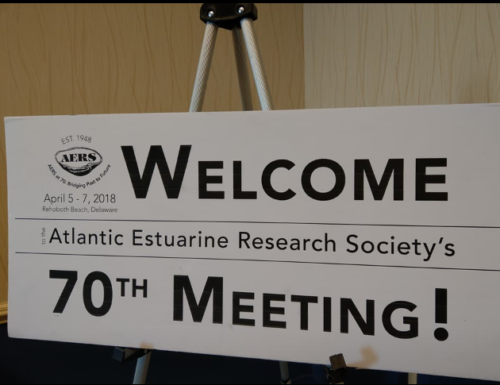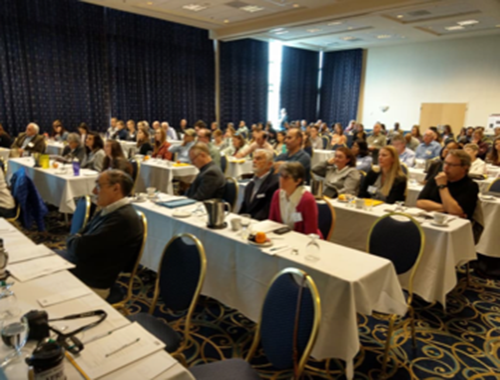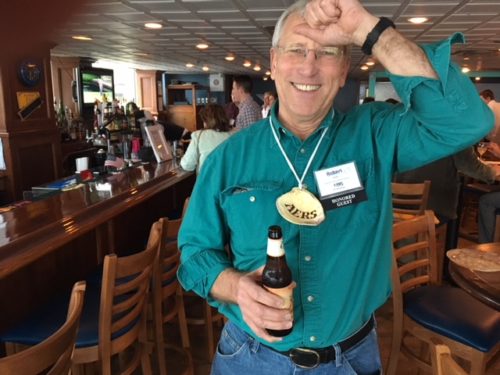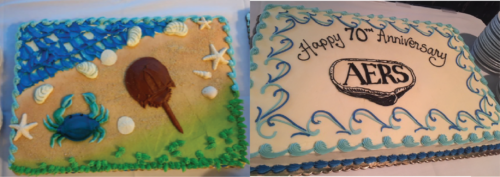Atlantic Estuarine Research Society 70th anniversary conference
Bill Dennison ·On April 6th-7th, 2018, I attended the Atlantic Estuarine Research Society (AERS) annual spring conference in Rehoboth Beach, DE. AERs was the first estuarine scientific society created, and this conference marked the 70th anniversary of its founding. Citing a need for communication among associates in the coastal regions of the Chesapeake and Carolinas, the first AERS meeting was held in April 1949 in Morehead City, NC. Over the next two decades, marine programs along the Atlantic coast increased dramatically, and the need for broader representation was necessary. In 1971, AERS joined forces with the New England Estuarine Research Society (NEERS), formed in 1969, to create the Estuarine Research Federation (ERF) to encourage estuarine and coastal research in the United States and other countries. ERF was renamed Coastal and Estuarine Research Federation (CERF) and now has seven affiliate societies1.

Given this history, I was very glad that could join in the celebration of AERS’s 70th year, since its founding was the genesis of such an important scientific society. We had 70 students attend and present, one for each year, so there were many students presenting their data in oral or poster presentations. I presented an ignite style talk, in which 20 slides are automatically advanced at 15 sec intervals. It was a bit nerve wracking to have the slides advance before you have finished describing each slide. My talk was titled “Data synthesis for environmental management: A case study of Chesapeake Bay.” I discussed the early synthesis efforts in Chesapeake Bay, and then outlined the three papers that we recently published as part of our Submerged Aquatic Vegetation synthesis (SAV SYN) effort, then concluded with the segment analysis now underway. Finally, I encouraged the scientists in the audience to undertake similar synthesis efforts in their respective fields.

My longtime colleague, Bob “JJ” Orth, gave a plenary talk about seagrasses that highlighted our collaborative efforts to synthesize seagrass trajectories globally through the National Center for Ecological Analysis and Synthesis (NCEAS). In addition, JJ highlighted our efforts with Chesapeake Bay analyses (SAV SYN) and ended by alluding to the climate change related challenges facing seagrasses in the future. After his talk, JJ was presented with the Venerable Clam, an award of AERS in which a knuckle salute is made to the venerable clam awardee.

Several estuarine scientists traveled down from NEERS to help us celebrate. In particular, the CERFtones, a rock band comprised of NEERS scientists played after dinner music at the banquet. We had a pleasant reception at the Rehoboth Dogfish Head brewery on the night before the conference. I met the CERFtones scientists at the reception and they wanted to know if I had any song requests for them. I mentioned “Seagrass Blue Carbon Blues” and they agreed to play it if I could supply a singer. I spotted Melanie Jackson, a Marine Estuarine and Environmental Science (MEES) graduate student at Horn Point Laboratory, across the room and was able to convince her to sing it accompanied by the CERFtones. So during the banquet, Melanie belted out a great rendition of “Seagrass Blue Carbon Blues.” I realized that this was the world premiere of a live performance of this song, which was originally recorded in an Australian studio by Gary Cox, the husband of my seagrass colleague Kieryn Kilminster. Currently, I am collaborating with Melanie on recording some songs I wrote for the Ecological Drought workshops that were held with US Geological Survey colleagues.

In addition to the CERFtones, our long term colleague, Veronica Berounsky from the University of Rhode Island, traveled down to Rehoboth Beach. Veronica’s son Ben Lee graduated with my daughter from St. Mary’s College of Maryland and is working at Horn Point Laboratory. We were able to reunite with Drs. Bob Paul and Chris Tanner, recently retired from the St. Mary’s faculty as well.
Over the long history of AERS, many notable people have been active. The first AERS President was the Director of the Chesapeake Biological Laboratory, Gene Cronin. More recently, Danielle Kreeger from the Partnership for the Delaware Estuary was AERS President, and Joe Luczkovich from East Carolina University assumed the presidency at this conference. My take away from this conference was that AERS conferences are fun, and AERS is thriving as a strong regional scientific society.
1The history of AERS was taken from AERS History in Brief , which cites the NEERS society evolution.
About the author
Bill Dennison

Dr. Bill Dennison is a Professor of Marine Science and Vice President for Science Application at the University of Maryland Center for Environmental Science.

